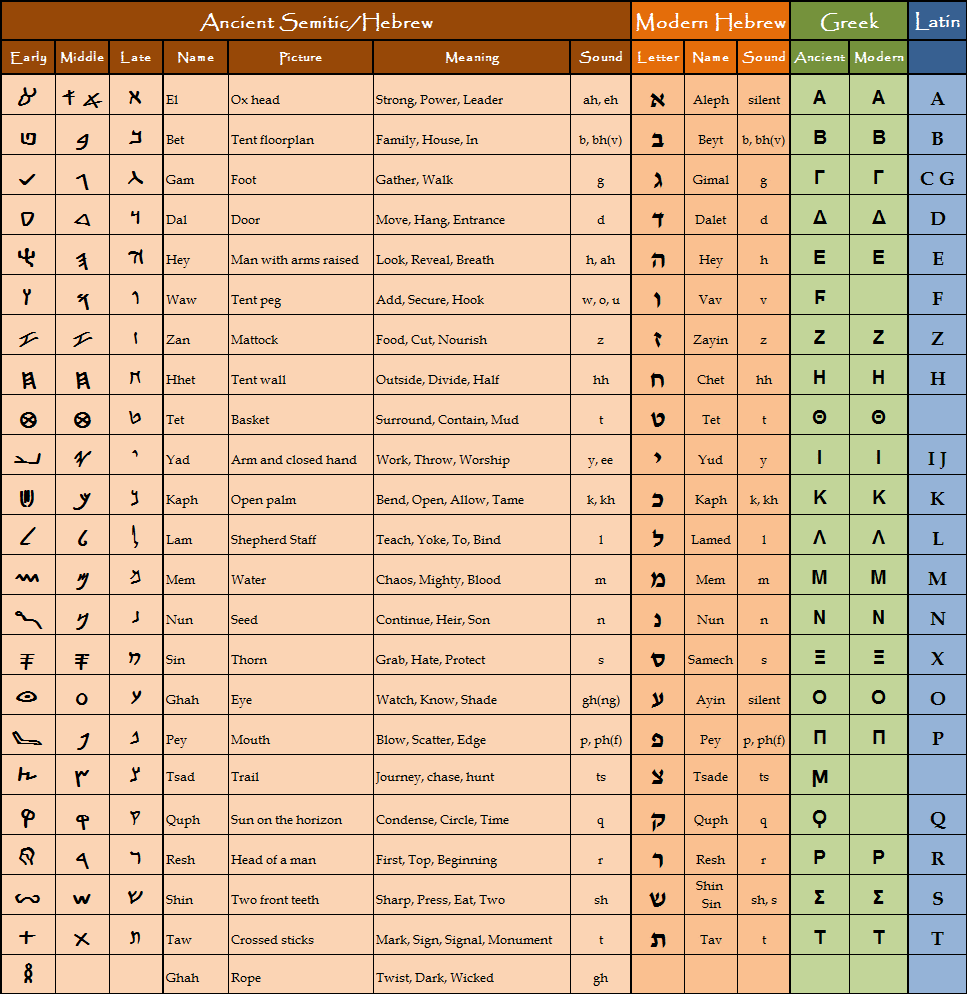
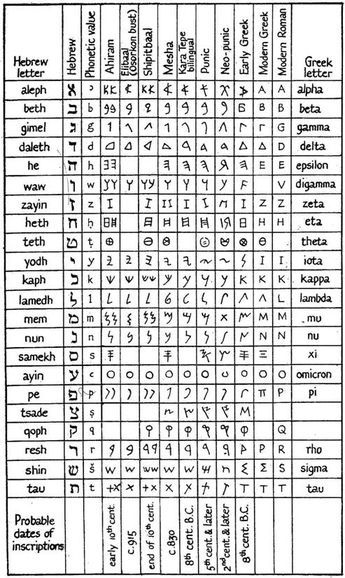
Was ENGLISH Derived From HEBREW?
Was English derived from Hebrew? The idiomatic likenesses between ENGLISH and HEBREW were noticed by Tyndale when he translated the scriptures. He said, "The properties of the HEBREW tongue aggreeth a thousand times more with the ENGLISH than with the LATIN. The manner of speaking is in both one, so that, in a thousand places, there needest not but to translate the HEBREW word for word." Canon Lyson found 5000 HEBREW ROOTS in the ENGLISH language (Our British Ancestors); other authorities put the figure still higher. The Welsh is so much like the Hebrew that the SAME SYNTAX may be used for both. The old SAXON language is said to be eighty percent HEBREW. The oldest poems in the CELTIC language are in the "Book of the Dun Cow" (1106 A.D.) and are "not unlike the poetical passages in the Old Testament" (5:626, Encyc. Brit. 11th). Taliesin expressly says in one of his poems, entitled "Angar Cyvyndawd," "My lore has been declared in HEBREW." When Noah Webster’s original dictionary traced many English words beyond German, French, Latin and Greek to their “Shemitic” origin, no one raised an eyebrow. Every learned person knew that Hebrew was the Mother Tongue. Isaac Mozeson's The Word traces many English words to their Hebrew roots.
Isaiah 28:11 says, "For with stammering lips and another tongue will he speak to this people" (Ephraim -- v.1). The Hebrew word for "stammering" here is "LAEG" reading right to left but English reads left to right so it would be pronounced GAEL in English. GAELIC is not only the foundation of the English language, but is still spoken in its primitive simplicity in many places in Wales, Scotland and the north of Ireland. God does speak to us through the English Bible (28:13).
Judges 12:6 says the Ephraimites had trouble pronouncing the aspirate "h" in Shibboleth. In Britain today, especially the Cockney, can't pronounce it either. You still hear, "Don't be so oggish with your horanges."
Speaking of the CELTIC use of the HEBREW rule of "ASPIRATION." Dr. Meyer says, "The assuming of the gutteral aspiration on the part of the consonant under the influence of the preceding vowel is the kind of change regularly adopted in IRISH, whereas in WELSH the vocalization of the mute is now the general rule. It is now unquestionable, however, from the gradual and even now only partial adoption of this rule in WELSH, that the IRISH usage is the MORE ANCIENT of the two, as is still further proved by its striking analogy with that of the DAGHESH LENE in HEBREW." Davidson's Hebrew Grammar says, "The word Daghesh is from a root which possibly expressed the idea of hardness. The sign of Daghesh is a point in the bosom of a letter, and this poiint was used to indicate both a lighter and a heavier kind of hardness. When it indicates the lighter hardness it is called D. lene, when the stronger, it is called D. forte."
You can take any SENTENCE in HEBREW and change it into GAELIC, word for word, WITHOUT ALTERING the ORDER of a single word or particle, and you will have the correct GAELIC idiom in every case. You cannot do that with any other language in Europe. HEBREW has a rule which is known as "ASPIRATION." which applies to certain consonants when they follow a vowel. It means the same consonant has two different sounds, according to its position. GAELIC has the SAME rule and applies it in exactly the same way. Even words borrowed from other languages are at once modified in sound according to the HEBREW rule of ASPIRATION. Does any other language use this rule? We don't know of any.
Ancient MEDIA,where the ten tribes were taken captive, is where the language of SANSKRIT developed. SANSKRIT has a more elaborate rule for modifying the consonants, called "SANDHI" under which every consonant may have as many as four distinct sounds, according to its position. Dr. Pritchard in his book The Eastern Origin of the Celtic Races has shown that WELSH alone of all living languages, has preserved the rule of SANDHI entire. He proves from this and many other similarities, including words in such common use as the whole paradigm of the verb "to be," that the ancestors of the WELSH must have lived among the people who spoke SANSKRIT. These people were ISRAELITES in MEDIA. He also shows that GOTHIC is the link between ancient SANSKRIT and modern TEUTONIC.
The grammatical structure of WELSH and HEBREW is the same. The VERB, for instance, occupies the SAME PLACE in the sentence of both languages. The ROOTS of most WELSH words may be traced to HEBREW. Not only do WELSH words themselves indicate a SIMILARITY; their VARIATIONS and INFLEXIONS afford a much stronger proof of affinity. In the CELTIC, as well as the HEBREW, the cases and gender of NOUNS are distinguished by AFFIXES and PREFIXES. The PLURAL number of nouns likewise is often formed in a similar manner in the CELTIC by adding "IN" to the singular. WELSH, like HEBREW, has NO PRESENT TENSE. In the formation of sentences, and in the government of words, in the AGREEMENT of the ADJECTIVE with the SUBSTANTIVE, in the precedence of the latter, in the usual EXCEPTIONS to this rule, and in VERBS PLURAL being GOVERNED by NOMINATIVES SINGULAR, the WELSH so exactly corresponds with the HEBREW that the SAME SYNTAX might serve for both. Meric Casaubon has taken some pains to show that the Saxon language has great affinity with the Greek (De Ling Sac. 234-376).
Instructors gladly condescend to teach,
By many rules the rudiments of speech;
That when the roots first of our own we gain,
The Hebrew tongue we then may soon attain.
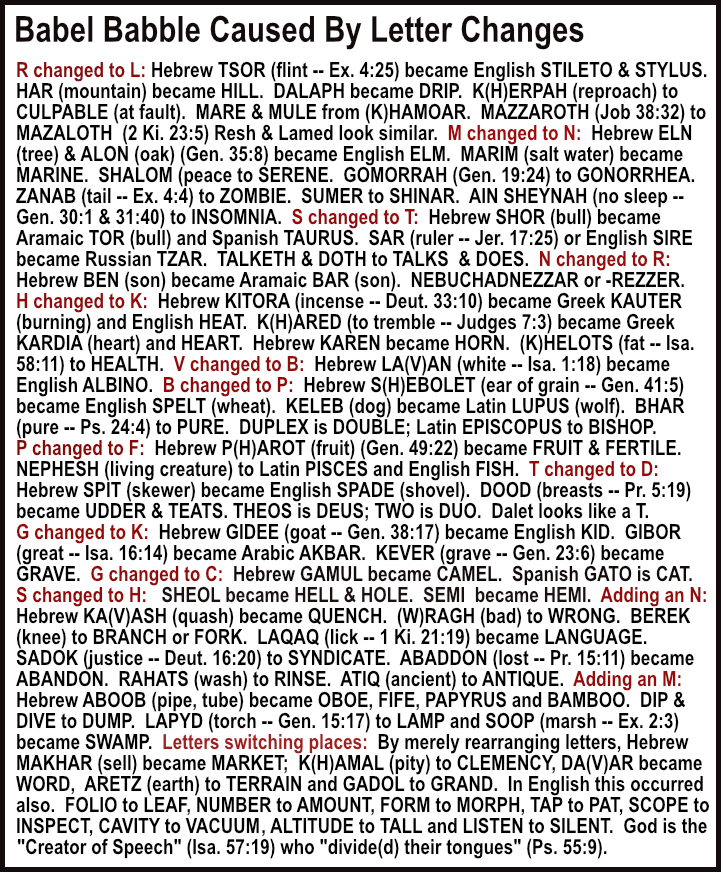

All our modern unabridged dictionaries are inadequate with regard to the origin or etymology of old ENGLISH words not derived from GREEK or LATIN. Very much of GREEK and LATIN and other European languages can be derived from HEBREW so the question becomes, "Did even those ENGLISH words that are similar to GREEK and LATIN come from them, or their predecessor HEBREW? These European languages are quite young compared with the old HEBREW. Pages 67 to 72 of God's Covenant Man British Israel gives many English roots from Hebrew.
The language of the learned bards, in which their poetry was conposed, was HEBREW. Taliesin, a celebrated bard of the ancient Britons, who was subsequently converted to Christianity, distinctly says, when speaking of his own songs, "My lore has been declared in HEBREW, in the HEBRAIC tongue have I sung." Dr. Thomas Stratton of Edinburgh said, "It would be difficult to adduce a single article or form of construction in the HEBREW grammar, but the same is to be found in WELSH, and there were many whole sentences in both languages exactly the same in the very words."
The HEBREW word for Festival is "MOED." The annual Scottish Gaelic musical festival is known as the "MOD." Another HEBREW word for Festival is "CHAG." The Scotch and Gaelic dance is called a "JIG." "HOORAY" or "HOORAH" comes from the HEBREW #7321 word for "shout" "ROOAH." CAIRN is the Irish pronunciation of the HEBREW QRN, meaning a "horn" which a CAIRN resembles in appearance. From this root the name of the Irish and Scottish hand-mill, the QUERN is derived; so called because the bottom stone is, at the top, in form of a horn on which the upper stone revolves. Professor Graves in 1855, speaking about an island at the mouth of the Kenmare River in Ireland, said that "The obvious and certain derivation of this name is Durs-ey, i.e. the 'Island of Dur,' DUR meaning water. The suffix "EY" meaning "island" in HEBREW is found in many names of British Islands such as Dalkey, Ireland's Eye, Lambay on the Irish coast, Anglesey, Orkney, Eday, Sanday, Bressay, Housay, Neay, Oxney (Isle of Oxen), Stokesay, Sheppey, Colonsay, Oronsay, Bardsey, Lundy, Guernsey, Jersey, Alderney, Menai and Thorney. Numbers 336 and 339 of Strong's give EE as the HEBREW sound for "island."Speaking before the British Association in 1847, James C. Pritchard, M.D., F.R.S. declared that Phoenician (HEBREW) writing was "the prototype of all the alphabets of ancient and modern Europe, and probably representing the form of letters in which the sacred Scriptures were originally written." He went on to say that languages constantly borrow words from other languages, but they seldom, if ever, borrow idioms. Consequently, idiomatic relationship is strong presumptive evidence of ethnological identity. J. W. Donaldson said in 1851 to the British Association: "Now modern philology leads us to the conclusion that the SEMITIC languages were originally built upon the same system of monosyllabic roots as the SANSCRIT and GREEK." ("British Association Reports," vol. 20, 1851, p.138 et seq.)
Notice the English "Rabbit" comes from the Hebrew "ARNBiT" (hare), the R and A reversed, the "Adder" from "ATaR" (to encircle), the "Kitten" from "QuiToN" (a little one), "Camel" from "GeMeL" (camel) and "Elephant" and "Antelope" from "ELePH" (ox). "Steer" from "SHOOR" (ox). "Caribou" from "BaQaR" (cattle), "Giraffe" from "GaRaPH" (the neck), "Pig" from "PiGGuL" (abomination), "Snake" from "NaKHaSH" (snake), "Serpent" from "SaRaPH" (to burn), "Snipe" from "INSOP" (water-fowl), the letters shuffled, "Dove" from "DOoB" (to murmur). "Turkey" and "Toucan" from "TooKeY" (exotic bird). "Sparrow" from "ZaPPOR" (sparrow). "Pelican" from "PeLeG" (a stream). "Raven" and "Robin" come from "OReB" (raven), "Crow" or "Rook" from "QRAW" (to call), "Egret" from "EGORT" (a crane), "Crane" from "GaRaN" (a throat), "Gull" from "GUL" (to move in a circuit), "Swallow" from "SaLO" (quail), "Osprey" from "PeRoS" (eagle), the S put in front, "Eagle" from "AKuL" (a devourer). "Fish" from "NePHeSH" (living creature), "Crab" from "AQRaB" (Scorpion), "Whelk" and "Leech," if we shuffle the letters, from "ELQ" (to adhere), "Haddock" from HaDDoQ" (a thorn), "Crayfish" from "ECVIS" (spider), "Wasp" from "AZB" (pain), "Moth" from "MOT" (little), "Worm" from "ORM" (naked). "Locust" from "LoQueSH" (to consume), "Gnat" from "NaD" (to fly), "Buzz" from "ZEBUB" (fly), OTSAR (storehouse -- Pr. 21:20) became OYSTER. "Shrub" from "ZhRuB" (to limit), "Berry" from "PeRi" (fruit in general), "Fruit" from "FRuCH" (to bud or blossom), "Branch" from "BRaCH" (to reach across), "Bark" from "BOOK" (to roll round), "Gum" from "GaM" (to join together), "Ash" from "AZH" (tree), "Elm" from "ALoN" (an oak), "Cypress" from "GOPHeR" (wood of Noah's ark), "Holly" from "HoLLeL"(pierces"), "Juniper" from "JuPeR" (sharp points), "Brush" from "BRuSH" (Fir), "Cedar" and "Citrus" and "Nectar" from QueTaR" (perfume), "Mistletoe" from "MaSL-TOH" (Lord of misrule). "Crocus" from "CRoCuM" (Saffron herb), "Nettle" from "NeTtO" (plant), "Squash" from "QuaSHA" (Cucumber), "Onion" from "OIN" (eye), "Cabbage" from "QaBaZH" (to gather together), "Turnip"and "Parsnip" from "NiB" (a plant), "Barley"from "BaR" (corn) plus "LaeH" (weary), "Lemon" and "Melon" from RIMMON (Pomegranate),"Peach" from "NePeCH" (citron) and "Raspberry" from "RaSP" (a red-hot coal). "Acre" (field in English) and "Agros" (field in Greek) from "EeKaR" (farmer), "Earth" (English) and "Terra" (Latin earth) from "AReTZ" (Earth)(For many more similarities, see English Derived From Hebrew by R. Govett and Our British Ancestors by Canon
Lyson, as well as The Word by Prof. Isaac E. Mozeson.
One of the usual arguments given as a reason for the assumed incongruity of Hebrew and English is that in Semitic, the “vast majority of roots …are composed of three consonants,” in contrast to European languages which are “biconsonantal,” using two consonants. However, scholars point out that other Semitic languages are not limited to three consonants per root, nor was this originally the case in early Hebrew. Instead, it was “an innovation” during Biblical times and after. (Bomhard, p.97, Journal of lndo-European Studies (vol. 5:55-99)). Another reason that non-scholars doubt a connection between the Hebrew and European languages is due to the totally different alphabet used in Modern Hebrew. The common Hebrew characters today are of a square design, but few are aware that this was also a late innovation. In the third century, B.C., a dispute between the Jews and the Samaritans resulted in the rabbis discarding the Pre-Exilic alphabet, and adopting the completely new square letter format in order to distinguish themselves and their writing from their hated neighbors. (“A Social History Of Hebrew,” by William H. Schniedewind, 2013, p.l 72) The old alphabetic letters, now commonly known as Paleo-Hebrew, lived on, having been adopted in a revised form by the Greeks and Romans, and ultimately developing into the European alphabet of today.The third main argument against a Hebrew-European language connection is that Hebrew reads from right to left, while modern European languages read left to right. Yet early Semitic languages sometimes read in either direction, just as some of the early European languages did as well, before the European dialects settled on an opposite format from Modern Hebrew. For a time, European languages were boustrophedon, sometimes switching direction from left or right. There is an interesting discussion on this subject by Dr. Peter Craigie in the Tyndale Bulletin 34:155-156 (1983). Plutarch not observing the Oriental way of writings reversed the letters. Thus the Egyptian city of On became No; Rhea became Hera; Neith became Athene.
Names of Places
Local names within "Keltic" countries prove occupation by Israelites and Canaanites. The names are taken from Keith Johnstone's Royal Atlas, and are arranged according to the probable Hebrew equivalents, which are mainly derived from the Appendix to Stanley's Sinai and Palestine; S. stands for Scotland, I. for Ireland, E.-W. for England and Wales, and F. for France.
ACHU, "meadow." Achu-more (S); Accouis, Acheux (F); Achi-l, Achi-ll (I.); Acha- occurs in 20 names (S.); Ach- in 22 (S.)
AIN, "spring." Ain-ort Loch (S.); An-dail Loch, Ann Burn, Ann-ack water, Ann-andale (S.); An-trim, An-ure (I.); Ain River, Ain-houe, Aisne River (F.)
AR, "city." Ar-gyle, Ar-isaig, Ar-nish, etc. 29 in all (S.); Ar-boe, Ar-magh, Ar-vagh, etc. 17 in all (I.); Ar-amitz, Ar-brois, Ar-tois, 53 in all (F.); the form Ard- occurs in 108 names (S. I. F.).
BAAL, the god of the Canaanites and idolatrous Israelites. Bal-carry, Bal-gair, Bal-naboth, etc. 86 in all (S.); Bal-carra, Bal-doyle, Bal-gatheran, etc. 106 in all (I.); Bal-a, Bal-combe, Bal's-ham, etc. 10 in all (E. W.); Bel-haven, Bel-dornie, Bel-fast, etc. 36 in all (S. I.). It is hardly necessary to mention that the forms in Bel-, referable to the French beau, bel, "beautiful" have not been included); Beal Point, Beal-derrig, Beal'-maha, etc. 11 times (S.I.). Isaac Taylor in Words and Places, adds Bell Hill and Hill Bell; Belan near Trefeglwys, in Montgomeryshire; Belan, near Newtown, two Belan Banks in Shropshire, the Baal Hills in Yorkshire; and Bal-erium, the ancient name of the Land's End.
BETH, "house". Everywhere in Palestine: Bethel, Bethany, Bethesda, Bethlehem, Bethsaida, etc. It is just as common in Wales.
BOZRA, "citadel" or "hill;" Phenician Bursa. Birsa, Birse, occurs 6 times (S.).
CARMEL, Carmel
Water (S.).;
CHOR, "hole." Chor-achan, Chor-ick Glen (S.); Choir Loch, Chuir-na Loch, Chur-in (S.).
GAI, "ravine." Gai-r Loch, Gai-rnog Water, Gai-thorpe burn etc. 16 in all (S.).
GAL, "bubbling spring" or "wave." Gal-a Water, Gal-braith, G-tc. 9 times (S.); Haer Fuads (Roman Camp); Hart, 6 times (S.); Har-wood, Har-ter Fell (E. W.); Har-court, Har-fleur, Har-one (F.)
IR, "city." Ir-ane, Ir-vine, Ir-en etc. 6 times (S.); Ir-by, Ir-chester, Ir-well, etc., 7 times (E.W.).;
KIRIAH, "fortress" or "city" seen by Dean Stanley in the Phenician Certa (pronounced Kerta), Car-thago. Caer Laverock Castle (S.); Caer-leon, Caer-marthen, Caer-narvon, etc. 14 times in all (E. W.); Car- occurs 106 times (S.I.E.W.F.) as in Car-lisle, Car-digan; so Caer-narvon is ofter spelt Car-narvon.
KAL, a root meaning "prison" or "fortress."
Cala, Cal-der, Cal-gary, etc. 32 in all (S.); Cal-hame, Cal-lan, Cal-tragh, 8 in all (I.); Kel occurs 16 times (S.). Cf. Cal-neh, which is supposed to mean the "fortress of the god Ana."
MARA-ZION is a town in Cornwall; the name speaks for itself.
MAAN, "springs." Main River, Maine River, Main-ham (I.)
MAKOR, "well-spring." Maghar-ee
Is.; Magher-a, Magher-amore, etc. 14 in all (I.).
MECHILLOTH, "fissures." Macgilli-cuddy Reeks, Magilli-gan Point (I.)
ROSH, "head of a mountain." Rosh-k Loch (S.); Rosh-in (I.); The Ross-es (i.); Ross- occurs 41 times (S.I.E.W.); Ros- 18 times (S.I.E.W.F.); Rooss (E.W.); Roos (i.), Les Rousses, and Rouss-illon (F.) are probably to be referred to the same origin. Ros and ross also frequently occur elsewhere than at the beginning of names, as in Muck-ross, Ard-ross-an, etc.
SHEN, "crag of a cliff." Shen-well (S.); Shan- 14 times (S.I.); Shean, Sheen Water, Sheen River, Shin-naah,Shin-rone (S.I.).
TSUR, or Tur, "rock." Phenician Tyre. Tor- occurs 51 times (S.I.E.W.); Toor- 4 times (I.).
Why is Hebrew Read Right to Left?
Direction of writing HEBREW is RIGHT to LEFT while ENGLISH is LEFT to RIGHT. Therefore critics argue that the English couldn't be Israelites. But the Anglo-Saxon tongue was largely an UNWRITTEN one prior to their settlement in Britain. Speaking of the "Alphabet and its Origin" at a meeting of the British Association in 1872, John Evans, F.R.S., F.S.A. says, "If the date which has been assigned to the famous 'Moabite stone,' of about 900 B.C., be correct, the correspondence in form between the archaic GREEK letters and those on the stone raises a strong presumption in favor of letters having been imported into Greece at the time when the PHOENICIAN alphabet was in that stage of development in which it occurs on the stone. Even the name of the alphabet preserves the memory of its PHOENICIAN origin, for Alpha and Beta, the names of the two letters from which the word is derived, are not really GREEK, but merely the Hellenized form of the PHOENICIAN (i.e. HEBREW) Aleph and Beth. The same is the case with the names of all the other GREEK letters down to Tau.... It must, however, be remembered, that the letters (of the Moabite Stone) are written from RIGHT to LEFT, or in the same manner as HEBREW, and not as is the case with us, from LEFT to RIGHT. In the early GREEK inscriptions it appears to have been a matter of INDIFFERENCE in which DIRECTION the letters were placed. In some the lines are alternately in EITHER DIRECTION; and this form of writing was known as Boustrophedon, or that which turned BACKWARDS and FORWARDS like an ox in ploughing.... The language of the HEBREW Scriptures may practically be regarded as the same as the PHOENICIAN" ("British Association Reports," 1872, Transactions, p.181 et seq.).
The Encyclopedia Britannica, 14th edition, vol.3, p.972, article "Boustro- phedon," says: "A term descriptive of a peculiar form of writing common among the early GREEKS. The direction of writing was alternately RIGHT to LEFT and LEFT to RIGHT in horizontal lines, or conversely, LEFT to RIGHT and RIGHT to LEFT. It was a transition between the earlier RIGHT to LEFT writing and the later LEFT to RIGHT style. The term was derived from two Greek words meaning "ox" and "to turn," from the resemblance of the writing to the winding course taken by oxen in ploughing."
Sir Charles Marston in The Bible Comes Alive says, "It will be seen, from the archaeological evidence cited in these pages, that the Israelites had, from the time of Moses onward, at least three alphabetical scripts. First, what is known as the SINAI HEBREW; next, what is known as PHOENICIAN HEBREW; and lastly, after the captivity in Babylon, what is known as the ASSYRIAN HEBREW." (p.8). "So far as is known at present, it would seem as though the SINAI HEBREW script usually reads from LEFT to RIGHT, like our own writing, while the PHOENICIAN HEBREW reads from RIGHT to LEFT, like modern Hebrew."
Professor Stephen Langdon, M.A., B.D., Ph.D., F.B.A., Professor of Assyriology at Oxford, wrote, in a letter to the "Times" on 5th October, 1935, with reference to the SINAI HEBREW inscription on the Lachish Red Bowl which had been published in that journal on 24th June, under the title "Antiquities from Lachish" by J.L. Starkey: "The inscription as published in the 'Times' should be INVERTED and read from LEFT to RIGHT; for this was the original direction of writing the SINAITIC script."
The Lacedemonians wrote GREEK from LEFT to RIGHT; yet they were Israelites (1 Maccabees 12:6-23).
Was RUNIC Derived From HEBREW?
The early Saxon alphabet contained letters before its contact with Greece or Rome. The old Runes are letters. The Saxons had terms of their own, not borrowed from Latin, for alphabetical letters. Writing is expressed in Saxon by a verb not of Roman origin. Saxons didn't derive their word for "book" from "liber." However there are numerous points of resemblance between the ancient British (or Runic) alphabet and those of the ancient Hebrews and Phoenicians (Haigh's Conquest of Britain By The Saxons, pp.33, 68, 88, 106, 107). The futhoric, or Runic alphabet, originated, "clearly in times of primitive antiquity. The nomenclature of the Phoenician-Hebrew alphabet is admitted to indicate its having originated in a primitive state of society, and that of the futhoric has precisely the SAME CHARACTER. Indeed it is remarkable how many of the objects named are COMMON to BOTH, how IDENTICAL was the feeling which dictated in each case the choice of the SYMBOLS.... the remarkable coincidence in both systems, commencing with the names of domestic cattle." One of the earliest of these futhorics consisted of SIXTEEN runes; so also did the early Phoenician. As in Phoenician and Hebrew, so on Runic monuments in Norway and Sweden, writing is found from was RIGHT to LEFT. In the symbols employed there are several parallels. "ALEPH, the first character of the Hebrew and Phoenician alphabet, was the head of an OX with its horns; FEOH, the first letter of the Runic, with the same meaning, is but a variant of the same symbol, and corresponds very nearly with the Samaritan character.... THORN, the third rune, is certainly allied to DALETH, and as the latter is a "DOOR," so we may regard the former (of which Thur is one of the variants) as thurn or durn, with the same signification. The Phoenician-Hebrew letters KOPH and RESCH symbolize and signify the "HEAD"; the Greek Rho is identical with the primitive Resch; the Latin R and the Runic RAED differ from it only in the addition of a beard; whilst the Runic WAEN, again, has the primitive form.... The Phoenician CHETH or HETH has sometimes exactly the form of the Anglo-Saxon HAEGEL; it means and represents an "ENCLOSURE" or "PARK" and it is very probable that HAEGEL means the same, for HAEGE is a "HEDGE" and HAEGIAN to "HEDGE" would admit of a derivative noun HAEGEL.... The Phoenician-Hebrew LAMED is a "WHIP," "ROD" or "GOAD"; the Runic LAGU has the form of a "WHIP," the symbol of authority in Egyptian hieroglyphics. Its meaning is "LAW." CALC has the form of a THUNDERBOLT which characterizes Nin in the Assyrian sculptures, and when his title "KHALK-halla, "brother of the lightning" and the name of his father's sacred city KALK-ha are considered, we must conclude that the word signified what the form of the character denotes. STAN has the form in which the Phoenicians cast their pigs of TIN, and is stamped as a symbol on one so formed, found in Cornwall, and now in Truro Museum; it is therefore extremely probable that the word, like the Latin STANNUM, means "TIN." Lastly, the Runic COPULATIVE sign has precisely the ancient form of VAU, which means a "HOOK," and as such became in Hebrew the COPULATIVE conjunction.
Thus we see that the PHOENICIAN alphabet and the Anglo-Saxon FUTHORIC are derived from a common source; that the same feeling dictated the choice of the symbols, which were to be used as letters in each case; and that each letter represents the initial sound of the name of the corresponding symbol. It must be remembered that the regular square Hebrew type was a comparatively LATE invention, and that the early PHOENICIAN-HEBREW forms were those familiar to the Israelites of the captivity of 721 B.C. Comparing HEBREW-PHOENICIAN with RUNIC suggests that RUNIC consisted of old HEBREW letters. There are many cases where the very SAME FORM is used for two different letters in Hebrew and Runic.
Isaac Taylor, in his work on the RUNIC characters accounts for the spread of RUNIC characters from the Black Sea to the Baltic by saying that the Goths were formerly Getae. The RUNIC came to the North from Asgard -- a place which Taylor identifies with the Gerrhos of Herodotus. This theory supports the statement of Snorri Sturleson that Odin introduced written characters into the North. Odin produced a "FUTHORIC" alphabet whose RUNIC characters bear a strange likeness to the characters used by the Greek colonists of the Black Sea littoral -- characters which can be traced back as far as that coin of King Geta of the Edoni by the River Strymon in Thrace, the identical coin that found its way into the bed of the River Euphrates near Babylon. "Goth" is undoubtedly derived from Guta-theod. Theod being old English for "a people." Goth therefore means the "people of Guta." We met a "people of Gutium" on the inscriptions of Cyrus. The Getae of Trajan's column have an appearance and dress that is identical to the frescoes of the captive Goths from the Constantinople column even though centuries apart.
Did Jesus Speak Hebrew?
In Eusebius' Ecclesiastical History 3:39:16 , Papias (c. 130 A.D.) says, "Matthew composed his history in the HEBREW dialect, and every one translated it as he was able." Apparently the Greek versions of Matthew, Mark and Luke are not originals. There was a HEBREW original of Matthew that has been lost. Some scholars have mistakenly claimed that the word for "HEBREW" should be understood as "Aramaic." The article by J. Grintz, "Hebrew as the Spoken and Written Language in the Last Days of the Second Temple," Journal of Biblical Literature 79 (1960) 32- 47 has proved this claim false. It is true that three centuries before Jesus, Alexander the Great spread Greek culture and Greek ways throughout his empire and the Greek language was widely spoken during New Testament times. But within the land of Israel there was strong resistance to pagan Hellenization.
The Letter of Aristeas is written in Greek. Interestingly, it explains that the spoken language of the Jewish people in the land of Israel was HEBREW. While it would not be correct to say that HEBREW was the only language understood and spoken by the Jewish people during the time of Jesus, there is abundant evidence that the people's holy books, prayers, studies in the classroom, parables, and quite naturally then, their everyday speech, was in HEBREW. Jesus clearly spoke HEBREW in Acts 26:14. Paul clearly spoke HEBREW in Acts 21:40 and 22:2. In John 5:2, Revelation 9:11 and 16:16 we find HEBREW place names. The sign on the cross was in HEBREW, Latin and Greek (John 19:20). There is no mention of Aramaic. The Gospel of Mark contains a few Aramaic words,and this was what misled scholars. Today, after the discovery of the Hebrew Ben Sira (Ecclesiasticus), of the Dead Sea Scrolls, and of the Bar Kokhba Letters, it is accepted that most people were fluent in HEBREW. The Pentateuch was translated into Aramaic for the benefit of the lower strata of the population. The parables in the Rabbinic literature, on the other hand, were delivered in HEBREW at all periods. There are sayings of Jesus which can be rendered only into HEBREW. The Hebrew origins of the Gospels can therefore be demonstrated by retranslating them from Greek back into Hebrew.Paul's Epistles were composed originally in Greek, but the terminology is still HEBREW.
With the exception of Matthew, a majority of Old Testament quotations found in the New Testament are from the GREEK SEPTUAGINT rather than the Hebrew Masoretic Text, but we don't know if this was the pen of the translator or the original. Jesus probably knew KOINE GREEK by hearing it spoken all around him. He was probably familiar with AESOP'S FABLES since he contrasted John the Baptist's unyielding nature to "a reed shaken with the wind" (Matt. 11:7), implying instead that he opposed Herod (the storm) like an Oak tree in the parable of the Oak and the Reed. Another parable of AESOP is the Fox and the Vineyard whose moral is similar to Jesus' remark about "It is easier for a camel to go through the eye of a needle, than for a rich man to enter into the Kingdom of God" (Matt. 19:24). The fox had to fast three days before it could squeeze through the hedge to the vineyard. It could only get out by the same lean method. Celsus even charged (C. Cels. Orig. 6:16) that Jesus took his remark from PLATO who said, "it is impossible for a man to be pre-eminent in his virtue, when he is exceedingly rich" (Laws 743A). However, the Essenes in 1 QS also mentioned the impossibility of serving God if one's desire is earning money.
Hebrew Scripture often rhymes. The earth became "without form ("TOHU) and void ("BOHU")" (Gen.1:2) God said to the man and woman, "be fruitful ("PERU") and increase ("REBU") in number" (1:28) "God formed the human ("HA ADAM") from humus ("ADAMAH") (Gen.2:7,20). In Genesis 11:9 we read, "It was called Babel ('BABHEL") because there the Lord made a babble ("BALAL") of the language of all the earth." In Ruth 4:1 we read of "a certain one" ("PELONI ALMONI") In Isaiah 5:7 we read about "He looked for morality ("MISHPAT"), but behold, a massacre" ("MISPAH"), for right ("SEDAQAH"), but behold, a riot ("SE'AQAH"). Jeremiah 1:11-12 talks about an "almond tree " ("SHAQED") and "watching" ("SHOQED") In Amos 8:1-2 we read about "ripe fruit ("QAYITZ") and the "time is ripe" or "end" ("QETZ"). Micah 6:3-4 says "I have burdened you" ("HELETIKHAH") and "I brought you up" ("HE'ELETIKHAH"). "With the jawbone of an ass ("HAMOR") I have piled them in a mass ("HAMAR")" (Judges 15:16). "You are Rocky ("PETROS"), and on this rock ("PETRA") I will build my church" (Matt.16:18). Jesus spoke in Aramaic "You strain out a gnat ("KALMA") but you gulp down a camel" ("GAMLA") (Matt.23:24) "God is able from these stones ("ABANIM") to raise up children ("BANIM") to Abraham" (Matt.3:9). "He should be called a NAZARENE" (Matt. 2:23) because he is "a Branch" (Isa. 11:1) or NETSER. There are hundreds of wordplays in the Old and New Testaments. Doctoral theses have been written on this subject alone.
Based on the HEBREW structure and words which show up underneath the Greek, most of the gospels were composed in HEBREW first. The similarity of sound disappears in Greek. When we translate the books of Matthew, Mark and Luke back into HEBREW, we notice many word plays which were very common as a means to help the Israelites facilitate memorization: In Matthew 1:21, "You will call his name Yeshua, for he will save ("yoshia") his people from their sins." Mark 1:13 says Jesus "was with the wild beasts" ("wehayah im hahayyah"). Luke 1:46 says "My soul exalts the Lord and my spirit exults in God my Savior." ("tagdel" and "wetagel"). In Matthew 3:9 "children" is "banim" and "stones" is "abanim." In Matthew 6:12-13 and Luke 11:4 "forgive" comes from "nasa," "debts" and "debtors" from "nashah," and "temptation" from "nasah." In Mark 2:6 the scribes "sit" and "reflect": "yoshebim" "wehoshebim." In Mark 3:10 those who seek to touch ("naga") Jesus are, not the sick but those who had all types of afflictions ("nega"). In Mark 3:14-15 "to send" comes from "shalah," "to have power" comes from "shalat," and "to cast out" from "shalak." In Mark 4:6 and Matthew 13:6 the word "sun" ("shemesh") is phonetically linked to the word "root" ("shoresh"). In Mark 6:38 Jesus says to "them" ("lahem"), how much "bread" ("lechem") do you "have" ("lakem")? "Go" ... ("lekou")." In Mark 2:21 and Matthew 9:16 a "tear" or "qera" grows "worse" or "ra." In Mark 9:18 the possessed "foams" at the mouth ("weyaraq") and "grinds his teeth" ("weharaq"). In Mark 10:34 and Luke 18:32 Jesus says he will be "mocked" ("wesahaqu bo") and "spat on" ("weyarequ bo"). In Mark 11:15 and Matthew 21:12, the "tables" of the money "changers" are "shulehanot" and "shulehanim." In Mark 13:8, Matthew 24:7 and Luke 21:11 Jesus predicts earthquakes ("raashim") and famines ("raabim"). In Mark 13:21 "See here ... see there" corresponds to "hinneh hennah ... hinneh hennah." In Mark 14:11 the high priests listened ("wayyishmeu") and were delighted ("wayyismehu"). In Mark 14:16 the two disciples "leave ("wayyeseu") ... and find" ("wayyimseu"). In Mark 14:41 and Matthew 26:45 "sleep and take your rest", according to Delitzsch's Hebrew translation of the New Testament is "numu wenuhu." In Mark 14:65 to "blindfold" (the face) and to "hit" correspond to the roots "satar" and "satar", and perhaps to the very same causative form. In Matthew 9:8 the words "they saw" ("wayyiru") and "they feared" ("wayyiru") are closely associated. The same coincidence is to be found in Matthew 14:30 and 27:54 and Mark 5:15 and in John 6:19, but nowhere else in the New Testament, and therefore never in works written in Greek. On the other hand, it is found sixteen times in the Old Testament. Matthew 14:12 says, "His disciples came ("wayyiqrebu") and took the body and buried it" ("wayyiqberu"). Mark 14:34 says, "Stay and watch," but Matthew 26:38 adds "with me" to obtain "imdu" ("stay") and "immadi" ("with me"). For more, see Jean Carmignac's The Birth of the Synoptics.
Robert B. Y. Scott (1899-1987), a clergyman of the United Church of Canada, Old Testament scholar, and former chairman of the Department of Religion at Princeton University said: "We come to the conclusion, therefore that the Apocalypse (Book of Revelation) as a whole is a translation from Hebrew or Aramaic." (The Original Language of the Apocalypse, U of Toronto Press, 1928)
Those who have not studied the Hebrew may be surprised why certain letters are considered as fixing the meaning of the word, and others as of no importance; in that language they are distinguished as radical and servile, a difference which may be traced in all languages. As in English, m, n, t (as th), and s, and all the vowels, are servile, or changeable, modifying, not changing the sense of the word. Thus meat is what we eat, oxen is the plural of ox, they the plural of he, she the feminine of he. The verbs exemplify the changes of the vowels, as sat, set, sit, and sot, one who has sat too long to drink. So of all the Northern dialects. In Arabic, though grammars do not so call them, these letters are used as servile. The Greek affords similar instances; in Latin and all its derived languages, the same usage is obvious. Thus therefore in the name Sirius, the identity with Seir the Arabic, and Oseir or Osir in the ancient Egyptian, has never been questioned; the English and French Sire, the English Sir, are obvious derivatives from the primitive root of Sirius, which means to rule. Again, in the name Orion, the final n is according to the Arabic usage intensitive, giving force. The word does not perhaps at present exist in this particular form in Hebrew, but is regularly formed by the Hebrew usage, as he who cometh forth, as also by the Arabic, he who cometh. Both these names, however, we have through the Greeks.
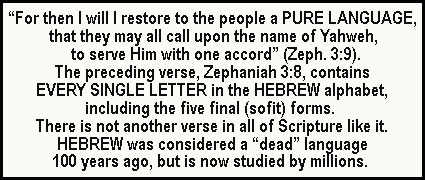
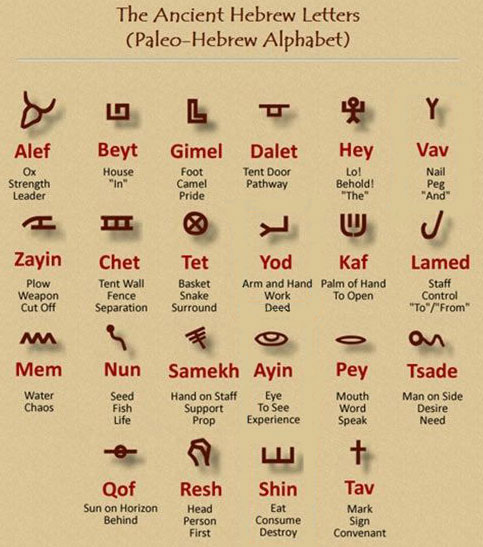
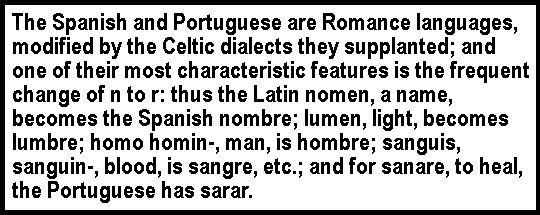
Next Lesson: Who Was Redeemed -- Oholah
Or Oholibah? | Back to Home | Email
Us